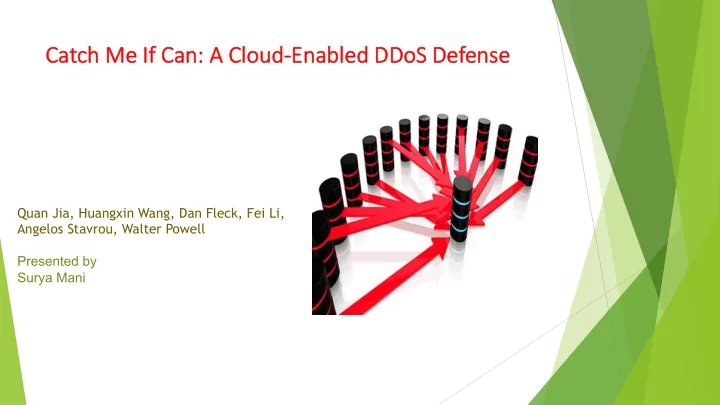

Ca Catch ch M Me If Ca e If Can: A Cl A Clou oud-En -Enabled ed DDoS DDoS De Defen ense e Quan Jia, Huangxin Wang, Dan Fleck, Fei Li, Angelos Stavrou, Walter Powell Presented by Surya Mani
Content u Motivation u Related Work u Cloud-enabled DDoS Defense u Shuffling Based Segregation u Experimental Evaluation
Motivation u DDoS attacks is severest security threat to Internet Security u Drawbacks in Present Defense Schemes
What is DoS and DDoS?
Related Work u Filtering-based Approach And Capability Oriented Mechanism u Overlay-based Defense u Moving Target Defense u Fast Flux Technique u MOVE – Migration OVErlay u MOTAG – Moving Target defense
Cloud- Enabled DDoS Defense u Improvement over MOTAG system u Securing Internet services that support both authenticated and anonymous users against network and computational DDoS attacks u Selective Server Replication u By replicating the server, the attacked server is taken offline and recycled u Intelligent Client Reassignment u Shuffling: intelligently assigns client to the new replica server
System and Threat Model u Network DDoS attacks u Computational DDoS attacks u Attacks performed by Attacker-Controlled Botnets u Naïve bots u Persistent bots u DDoS detection- uses indicators or advanced traffic analysis technique u Cloud-Enabled DDoS Defense is deployed
System Architecture and Components Key Components u Load Balancer u Replica Servers u Coordination Server
1. Load Balancer u Client redirection u Client-to-server assignment using Load balancing algorithm u Keeps track of active replica servers u Like Round-Robin DNS load balancing
2. Replica Server u Replicate the protected servers u Enforce Whitelist-based filtering u When bombarded by DDoS attack, client-to-server shuffling takes place u Attacked replica server is recycled u Shuffling and non-shuffling replicas
3. Coordination Server u Directs real-time actions against DDoS attacks u Keep tracks of client-to-server assignment u Respond to DDoS attack by computing optimal shuffling plan u Decides the number of clients to be reassigned to new replica server u Communicates via a dedicated command and control channel
Shuffling Based Segregation - Structured method
Shuffling Based Segregation – Cont. u Coordination server’s decision for reassignment of clients to new replica server is by using u Dynamic Programming algorithm u Greedy choice algorithm
Notations
Theoretical problem modeling u Shuffling is determined randomly so we use probabilistic analysis u E(S) – expected number of benign clients to be saved in one round
Optimal Solution u Solve max {S(a,b,1)+S(N-a,M-b,P-1)} u Dynamic programming approach(bottom-up)
Algorithm u Runtime – O(N^3.M^2.P) Space – O(N.M.P)
Greedy Algorithm (Top-down approach) u Dynamic programming algorithm is inadequate for making real-time decisions u Greedy performs runtime shuffling decisions one replica server at a time u Makes a greedy choice by selecting one locally optimal solution and then solving the remaining sub problem u Runtime- O(N.M) u Space – O(P)
Algorithm evaluation
Maximum Likelihood Estimation(MLE) Algorithm u Used to estimate the probability of M(Persistent bots) going to attack X servers. I.e. X<=M<=N
Experimental Evaluation u Prototype-Based evaluation
u Simulation-Based Evaluation
THANK YOU
Recommend
More recommend